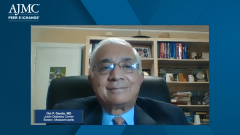
Improving Uptake of SGLT2 Inhibitors for Cardiorenal Metabolic Syndrome
Expert physicians discuss the underutilization of SGLT2 inhibitors and strategies to improve uptake in patients with cardiorenal metabolic syndrome.
Episodes in this series

Neil Minkoff, MD: One of the things that we’ve touched on is the underuse of these agents. There’s dramatic potential for increased use of SGLT2 inhibitors, and we’ve talked about cost as an issue. We’ve also somewhat talked about the time it takes to engage a patient and explain everything to them. What can we do to make primary care doctors or midlevel [heath care providers] feel more comfortable engaging and prescribing these so that we’re not waiting for the patient to progress and then end up in a specialized clinic before they get access to products that would make a significant difference being prescribed earlier rather than later?
Jeffrey Turner, MD: One thing all of the subspecialty areas do is try to educate in their niche area. For nephrology, we package it into what a primary care provider needs to know about managing kidney disease. In terms of our interactions with primary care, whether that be informally or formally in conferences, we take that approach to educate them early and often about changes that are happening. SGLT2 inhibitors are a great example. When we have all the data about SGLT2 inhibitors, I think there will be a postmortem about how we have such a breakthrough medication class, how it gets distributed, the knowledge about how to prescribe, and how the mechanisms that we’ve talked about get described. There’s a lot to be learned about that, how it’s been implemented with SGLT2 inhibitors, and this is another small component of that. It’s about educating the primary care community and packaging that, taking my specialty and putting it in a nice digestible way for primary care providers to nibble off this important high-yield fact that anybody with kidney disease and diabetes should be considering SGLT2 inhibitors as some of their first-line therapies.
Om P. Ganda, MD: That’s very well said. I would make the point, having been involved with some of the old studies like DCCT and still following those patients and UKPDS,that there are more studies like that, something called metabolic memory. The earlier you begin, the better the outcome. This is what the payers have to understand, and that message does not get through. We are very optimistic in the field that things will look better. It reminds me of how long it took for people to start using the higher dose or more intensive statin therapy. Even the early part after the 4S [trial], they said, “Oh, that patient is very well advanced to begin with. It doesn’t apply to us.” Now we know how far we have come, all the way from a goal of LDL [low-density lipoprotein] of 160 [mg/dL] to a goal of below 70 [mg/dL]; the Endocrine Society says 50 [mg/dL], and so does the European Society [of Cardiology]. We’ll get there, but hopefully we won’t have to wait as long as we did with some of the other lifesaving drugs like statins.
Nihar R. Desai, MD, MPH: Just to build on what Dr Ganda and Dr Turner said, there’s a lot of work for the providers to do in terms of education, empowerment, and coming together for primary care with cardiology, endocrinology, and nephrology, but it is broader than that. There’s also work for the quality measurement enterprise. What does quality mean for these patients? Maybe that requires a reassessment or reevaluation, reimagining what quality metrics really are and what that ecosystem is to reflect best care, and then partnering with payers. This is an area where the interests of the patients, providers, and payers can come together—where the use of high-value therapies could meaningfully improve the outcomes and lives for our patients, as well as reap some financial benefits to the payers. If we make it easy for the providers to prescribe these drugs and get access to what they want for their patients, it is an instance where cardiorenal and cardiometabolic care could be at the leading edge of what value-based care should look like, where the incentives are fully aligned. That would be a great story for our patients and one that we could all be proud of.
Transcript edited for clarity.
Newsletter
Stay ahead of policy, cost, and value—subscribe to AJMC for expert insights at the intersection of clinical care and health economics.






























































